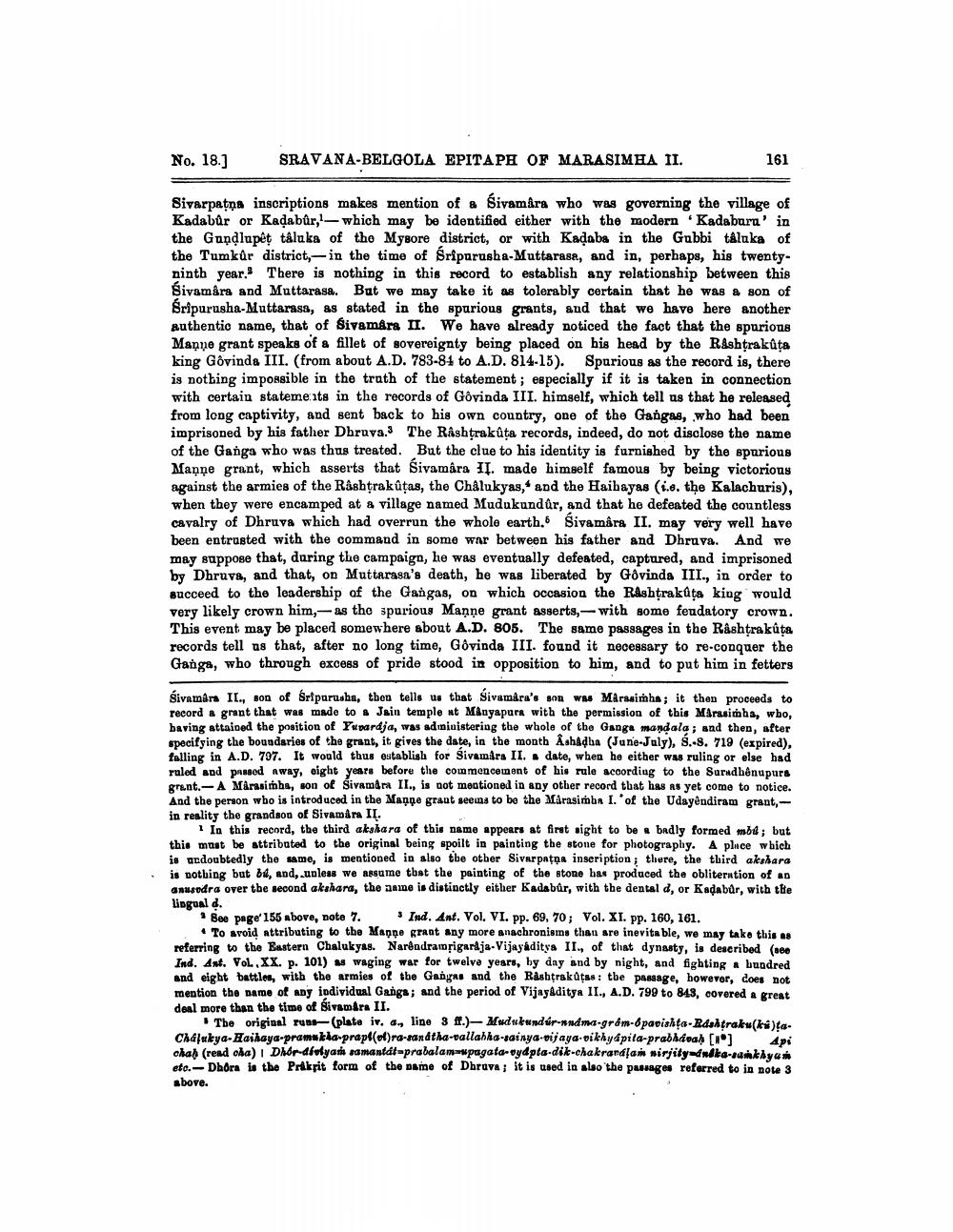________________
No. 18.]
SRAVANA-BELGOLA EPITAPH OF MARASIMHA II.
161
Sivarpatna inscriptions makes mention of a sivamara who was governing the village of Kadabûr or Kadabûr, which may be identified either with the modern Kadabara' in the Gundlupet tåluka of the Mysore district, or with Kadaba in the Gubbi tâluka of the Tumkûr district in the time of Sripurusha-Muttarase, and in, perhaps, his twentyninth year. There is nothing in this record to establish any relationship between this Sivamara and Muttarasa. Bat we may take it as tolerably certain that he was a son of Sripurusha-Muttarasa, as stated in the spurious grants, and that we have here another authentic name, that of Sivamâra II. We have already noticed the fact that the spurions Manne grant speaks of a fillet of sovereignty being placed on his head by the Rashtrakata king Govinda III. (from about A.D. 783-84 to A.D. 814-15). Spurious as the record is, there is nothing impossible in the truth of the statement; especially if it is taken in connection with certain statemeats in the records of Govinda III. himself, which tell us that he released from long captivity, and sent back to his own country, one of the Gangas, who had been imprisoned by his father Dbrava. The Rashtrakůta records, indeed, do not disclose the name of the Ganga who was thus treated. But the clue to his identity is furnished by the spurious Manne grant, which asserts that Sivamâra II. made himself famous by being victorious against the armies of the Rashtrakūtas, the Chalukyas, and the Haibayas (i.e. the Kalachuris), when they were encamped at a village named Mudukundur, and that he defeated the countless cavalry of Dhruva which had overrun the whole earth.6 Sivamâra II. may very well have been entrusted with the command in some war between his father and Dhruva. And we may suppose that, during the campaign, he was eventually defeated, captured, and imprisoned by Dhruva, and that, on Muttarasa's death, he was liberated by Govinda III., in order to gucceed to the leadership of the Gangas, on which occasion the Rashtrakūta king would very likely crown him,- as the spurious Maņņe grant asserts, - with some feudatory crown. This event may be placed somewhere about A.D. 805. The same passages in the Rashtrakůta records tell us that, after no long time, Govinda III. found it necessary to re-conquer the Ganga, who through excess of pride stood in opposition to him, and to put him in fetters
śivamara II., son of Sriparusha, then tells us that Sivamara's son was MArasimha; it then proceeds to record a grant that was made to a Jain temple at Mångapurs with the permission of this Marasimha, who, baving attained the position of Yuvardja, was adiniuistering the whole of the Ganga mandaly; and then, after specifying the boundaries of the grant, it gives the date, in the month Åshadba (June-July), 5.-8. 719 (expired), falling in A.D. 797. It would thus establish for Sivamara II. « date, when he either was ruling or else had ruled and passed away, eight years before the commencement of his rule according to the Saradhênupurs grent.- A Marasimha, son of Sivamara II., is not mentioned in any other record that has as yet come to notice. And the person who is introduced in the Manne graut seems to be the Marasimba I. of the Udayêndiram grant,in reality the grandson of Sivamara IL.
In this record, the third akshara of this name appears at first sight to be a badly formed mod; but this must be attributed to the original being spoilt in painting the stone for photography. A pluce which is undoubtedly the same, is mentioned in also the other Sivarpatoa inscription; there, the third akshara is nothing but bl, and, unless we assume that the painting of the stone has produced the obliteration of an
the second akahara, the name is distinctly either Kadabûr, with the dental d, or Kadabûr, with the lingual d.
1 Bee page 155 above, note 7. Ind. Ant. Vol. VI. pp. 69, 70; Vol. XI. pp. 160, 161.
To avoid attributing to the Manne grant any more anachronisms thau are inevitable, we may take this as referring to the Eastern Chalukyas. Narendramrigarija-Vijayaditya II., of that dynasty, is described (160 Ind. Ant. VoL, XX. p. 101) as waging war for twelve years, by day and by night, and fighting bundred and eight battle, with the armies of the Gangas and the Rashtraktas: tbe passage, however, does not mention the name of any individual Gangs; and the period of Vijay Aditya II., A.D. 799 to 843, covered a great deal more than the time of sivamara II.
The original run-(plate iv. a, line 3 ff.) - Mudulundur-andma.gram- pavisha-Edeltraku(ki)ta. Chafukya-Haihaya-pramukla prap (ol)ra-sandtha-vallahha-sainya-vijaya dikhydpila-prabudua) [°] Api chal (rend oha) Dhor.dbulyar samantataprabalama pagata-tydpta-dik-chakrandfa nirjilyuka-sukhya eto.-Dhora in the Prakrit form of the name of Dhruva; it is used in also the passages referred to in note 3 above.




